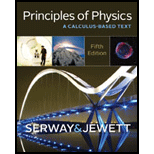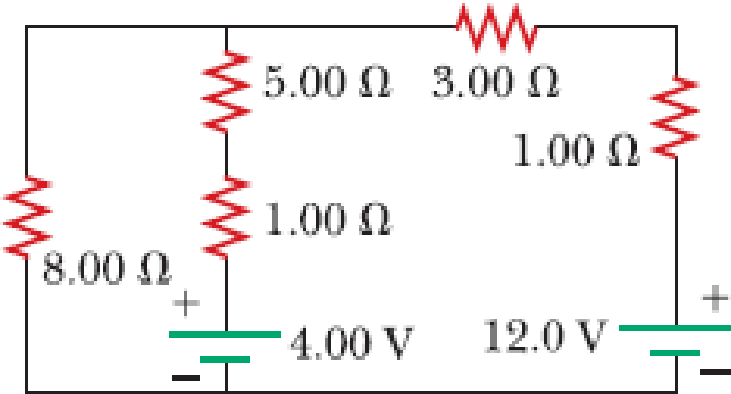
The circuit shown in Figure P21.47 is connected for 2.00 min. (a) Determine the current in each branch of the circuit. (b) Find the energy delivered by each battery. (c) Find the energy delivered to each resistor. (d) Identify the type of energy storage transformation that occurs in the operation of the circuit. (e) Find the total amount of energy transformed into internal energy in the resistors.
Figure P21.47 Problems 47 and 48.

(a)
The current in each branch of the circuit.
Answer to Problem 47P
The current
Explanation of Solution

Write the expression for the Kirchhoff’s loop rule in second loop from the left of the figure
Here,
Write the expression for the Kirchhoff’s loop rule in first loop from the left of the figure
Write the expression for the Kirchhoff’s junction rule in the figure
Use equation (III) in (I) and solve the equation.
Use equation (II) to solve for
Use equation (IV) in (V) to solve for
Use equation (VI) to solve for
Use equation (VII) in (V) to solve for
Use equation (VIII) and (VII)in (III) to solve for
Conclusion:
Therefore, the current
(b)
The energy delivered to each battery.
Answer to Problem 47P
The energy delivered to
Explanation of Solution
Write the expression for the energy delivered to the battery.
Here,
Write the expression for the
Here,
Use equation (XI) in (X) to solve for
Conclusion:
Substitute
Substitute
Therefore, the energy delivered to
(c)
The energy delivered to each resistor.
Answer to Problem 47P
The energy delivered to
Explanation of Solution
Write the expression for the energy delivered to the resistor.
Here,
Conclusion:
Substitute
Substitute
Substitute
Substitute
Substitute
Therefore, the energy delivered to
(d)
The type of energy transformation occurs in the operation of the circuit.
Answer to Problem 47P
The chemical energy is transformed to the internal energy in the resistors.
Explanation of Solution
The chemical energy in the
Conclusion:
Therefore, the chemical energy is transformed to the internal energy in the resistors.
(e)
The total amount of energy transformed into internal energy in the resistors.
Answer to Problem 47P
The total amount of energy transformed into internal energy in the resistors is
Explanation of Solution
Write the expression for the total amount of energy transformed into internal energy in the resistors.
Here,
Conclusion:
Substitute
Therefore, the total amount of energy transformed into internal energy in the resistors is
Want to see more full solutions like this?
Chapter 21 Solutions
Principles of Physics
- In the circuit of Figure P21.51, determine (a) the current in each resistor and (b) the potential difference across the 200- resistor. Figure P21.51arrow_forwardCalculate the power delivered to each resistor in the circuit shown in Figure P21.43. Figure P21.43arrow_forwardConsider the circuit shown in Figure P21.39. Find (a) the current in the 20.0- resistor and (b) the potential difference between points a and b. Figure P21.39arrow_forward
- Lightbulb A is marked 25.0 W 120. V, and lightbulb B is marked 100. W 120. V. These labels mean that each lightbulb has its respective power delivered to it when it is connected to a constant 120.-V source. (a) Find the resistance of each lightbulb. (b) During what time interval does 1.00 C pass into lightbulb A? (c) Is this charge different upon its exit versus its entry into the lightbulb? Explain. (d) In what time interval does 1.00 J pass into lightbulb A? (e) By what mechanisms does this energy enter and exit the lightbulb? Explain. (f) Find the cost of running lightbulb A continuously for 30.0 days, assuming the electric company sells its product at 0.110 per kWh.arrow_forwardLightbulb A is marked 25.0 W 120. V, and lightbulb B is marked 100. W 120. V. These labels mean that each lightbulb has its respective power delivered to it when it is connected to a constant 120.-V source. (a) Find the resistance of each lightbulb. (b) During what time interval does 1.00 C pass into lightbulb A? (c) Is this charge different upon its exit versus its entry into the lightbulb? Explain. (d) In what time interval does 1.00 J pass into lightbulb A? (e) By what mechanisms does this energy enter and exit the lightbulb? Explain. (f) Find the cost of running lightbulb A continuously for 30.0 days, assuming the electric company sells its product at 0.110 per kWh.arrow_forwardThe circuit shown in Figure P27.17 is connected for 2.00 min. (a) Determine the current in each branch of the circuit. (b) Find the energy delivered by each battery. (c) Find the energy delivered to each resistor. (d) Identify the type of energy storage transformation that occurs in the operation of the circuit. (e) Find the total amount of energy transformed into internal energy in the resistors.arrow_forward
- A battery is used to charge a capacitor through a resistor as shown in Figure P27.44. Show that half the energy supplied by the battery appears as internal energy in the resistor and half is stored in the capacitor. Figure P27.44arrow_forwardWhen resistors with different resistances are connected in parallel, which of the following must be the same for each resistor? Choose all correct answers, (a) potential difference (b) current (c) power delivered (d) charge entering each resistor in a given time interval (e) none of those answersarrow_forwardA child's electronic toy is supplied by three 1.58-V alkaline cells having internal resistances of 0.0200 inseries with a 1.53-V carbon-zinc dry cell having a 0.100- internal resistance. The load resistance is 10.0 . (a) Draw a circuit diagram of the toy and itsbatteries, (b) What current flows? (c) How much power is supplied to the load? (d) What is the internal resistance of the dry cell if it goes bad, resulting in only 0.500 W being supplied to the load?arrow_forward
- Calculate the equivalent resistance between points P and Q of the electrical network shown in Figure P29.80.arrow_forwardFigure P18.19 shows a Wheatstone bridge, a circuit used to precisely measure an unknown resistance R by varying Rvar until the ammeter reads zero current and the bridge is said to be balanced. If the bridge is balanced with Rvar = 9.00 , find (a) the value of the unknown resistance Rand (b) the current in the 1.00 resistor. (Hint: With the bridge balanced, the wire through the ammeter can effectively be removed from the circuit, leaving two pairs of resistors in parallel.) Figure Pl8.19arrow_forwardFigure P18.19 shows a Wheatstone bridge, a circuit used to precisely measure an unknown resistance R by varying Rvar until the ammeter reads zero current and the bridge is said to be balanced. If the bridge is balanced with Rvar = 9.00 , find (a) the value of the unknown resistance Rand (b) the current in the 1.00 resistor. (Hint: With the bridge balanced, the wire through the ammeter can effectively be removed from the circuit, leaving two pairs of resistors in parallel.) Figure Pl8.19arrow_forward
 Principles of Physics: A Calculus-Based TextPhysicsISBN:9781133104261Author:Raymond A. Serway, John W. JewettPublisher:Cengage Learning
Principles of Physics: A Calculus-Based TextPhysicsISBN:9781133104261Author:Raymond A. Serway, John W. JewettPublisher:Cengage Learning Physics for Scientists and Engineers with Modern ...PhysicsISBN:9781337553292Author:Raymond A. Serway, John W. JewettPublisher:Cengage Learning
Physics for Scientists and Engineers with Modern ...PhysicsISBN:9781337553292Author:Raymond A. Serway, John W. JewettPublisher:Cengage Learning Physics for Scientists and EngineersPhysicsISBN:9781337553278Author:Raymond A. Serway, John W. JewettPublisher:Cengage Learning
Physics for Scientists and EngineersPhysicsISBN:9781337553278Author:Raymond A. Serway, John W. JewettPublisher:Cengage Learning College PhysicsPhysicsISBN:9781285737027Author:Raymond A. Serway, Chris VuillePublisher:Cengage Learning
College PhysicsPhysicsISBN:9781285737027Author:Raymond A. Serway, Chris VuillePublisher:Cengage Learning College PhysicsPhysicsISBN:9781305952300Author:Raymond A. Serway, Chris VuillePublisher:Cengage Learning
College PhysicsPhysicsISBN:9781305952300Author:Raymond A. Serway, Chris VuillePublisher:Cengage Learning Physics for Scientists and Engineers, Technology ...PhysicsISBN:9781305116399Author:Raymond A. Serway, John W. JewettPublisher:Cengage Learning
Physics for Scientists and Engineers, Technology ...PhysicsISBN:9781305116399Author:Raymond A. Serway, John W. JewettPublisher:Cengage Learning





